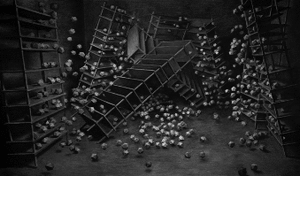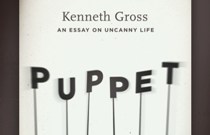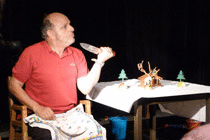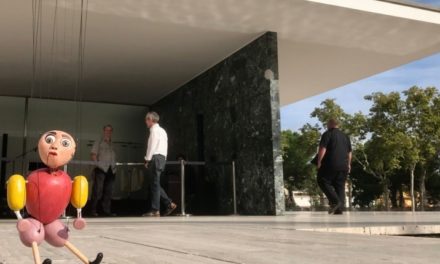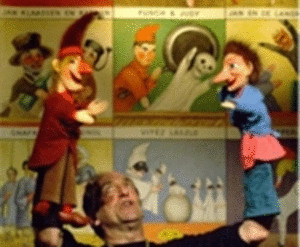LOOP Fair 2014, the annual video art fair, took place in Barcelona from 5th to 7th June, 2014. It is the largest fair of its kind worldwide, and is a well established event. While LOOP Fair is directed mainly at galleries and collectors, the public can visit – for a price – on Friday and Saturday evenings, while longer public exhibitions also takes place at Arts Santa Mònica and many other spaces in the city. In 2010 an eight-year retrospective was shown at Barcelona’s Arts Santa Mònica, featuring almost 50 pieces selected by the Los Angeles based commissioner Paul Young. Now in its twelfth year, the 2014 LOOP Fair hosted 46 works. The annual venue is the Catalonia Hotel Ramblas, each artist’s work being shown in one of the ground-floor hotel rooms. The rooms are compact and, with bed, armchairs or a small sofa and supplementary chairs, provide original and relaxed mini venues. The artist’s work is projected onto one of the walls thus being shown to excellent advantage.
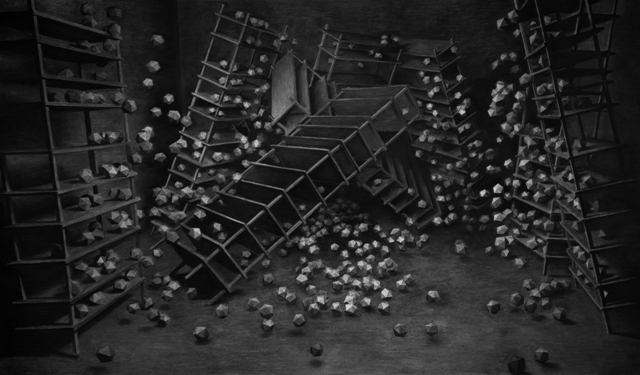
‘archive h264 7mbit’, from The Collapse of Cohesion 2014, Levi van Veluw
LOOP Fair hosts new or recent videos, and this year’s edition demonstrated the varied and often remarkably original ways in which the medium is used. As an infrequent viewer of video art, I found LOOP Fair 2014 exciting, stimulating and refreshing. I should mention that I went as a member of the general public, for whom visiting time is limited and, though I spent an afternoon and evening there, with so many works on show I was not able to see all 46 videos. Arriving too early, I went down to Drassanes, to see the pieces in the Maritime Museum. Of the works I saw, I write here about those I believe to have particular relevance to the theatrical interests (objects, shadows and puppets) of this magazine.
Objects were significant in a number of the videos; a few used animation; many pieces focused on the human body; and a surprising number were in some way related to water. Given this latter fact it was fitting that the Maritime Museum hosted five videos; work from private or semi-public collections, some by now classic or iconic work of the video art world.
Objects and controlled space
In the LOOP Fair at hotel Catalonia, three works featuring objects and effects produced upon or by them, with little or no on-screen human presence, were: a new work by Mohau Modisakeng, ‘The Escape’ by Anne-Valérie Gasc, and ‘The Collapse of Cohesion’ by Levi van Veluw.
In Modisakeng’s piece, lumps of a chemical substance (presumably sulphur) are added one by one to a bowl of water. When the chemical makes contact with the water it ignites, soon setting the little mound in motion. Smoke figures rise, producing a kind of abstract painting in motion. As each new lump is added, it joins what becomes a strange procession round the inside of the bowl. Filmed in low lighting and tightly framed, this curious landscape and activity produce a peculiar intensity, which is heightened by the uncertainty as to what will happen next with the smoking, perhaps explosive, material. The metaphorical force is enhanced when seen within the context of other work by this award-winning young South African artist. Charged with personal emotion, yet at one remove from the artist himself, and frequently dealing with questions of political violence, Mohau Modisakeng’s art often uses objects – for example a patch, as if planted, of upright samboks (ranch whips converted into a modern police weapon used for crowd control) – and is characterised by a pared down aesthetic, beautiful and, in a curious, sometimes uneasy way, serene, inviting contemplation.
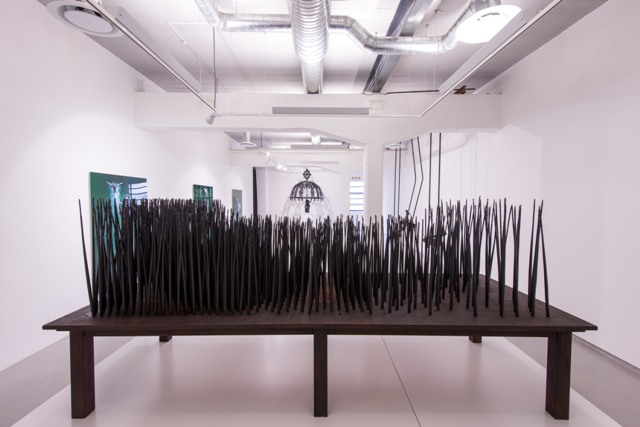
‘Untitled (Table)’ by Mohau Modisakeng. Photo from the magazine Nich Luxury Africa.
In ‘The Escape’ by Anne-Valérie Gasc the eruption actually happens. In this very short film (1’ 33”) the calm of a wide-shot view of an expanse of green grass in front of a long, palatial building on a summer’s day, is shattered as jets of water right across the frame erupt vertically from the lawn. They shoot up and, reaching different heights, play in the light, then disappear. “I am an explosives expert” says Anne-Valérie Gasc, quoting Michel Foucault.
In an interview about another piece of work, she talks about her invention, the “crashbox”, which allows her to film inside buildings as they are demolished, catching moments that are normally elusive – in French “insaisissables” -, outside experience; making visible what cannot usually be endured, “insupportable à la régard”. Anne-Valérie Gasc is interested in oxymorons, that is to say objects or ideas that say one thing and their opposite at the same time (“les oxymores, c’est à dire des objets ou des proposition qui disent une chose et son inverse à la fois.”). So there is a dialogue of a kind within the thing filmed, or rather, perhaps, provoked in the viewer in response to what is seen.
‘The Collapse of Cohesion’ is a series of short films based on drawings by the artist and video maker, Levi van Veluw. They are another example of a work where the artist first sets up a situation, and then an action provokes a change so that the objects react spontaneously within a contained, controlled environment. These uncontrolled spontaneous results are filmed. ‘The Collapse of Cohesion, 2014’ takes this to extremes, the crucial moment of falling apart being what is filmed after months of preparation. In ‘archive h264 7mbit’ the video features more than 1500 carefully arranged icosahedrons “held in place by the very structure of the cabinets and the force of gravity, in a continuous and ongoing struggle between the desire for order and the forces of nature. An unknown cause upsets this equilibrium…” Filmed at over 1000 frames per second, the time of the event is stretched. “Time, because of this massive slowing, seems to no longer affect the process of disruption. The icosahedrons float through the air, rotating, the glistening of the light that reflects on their 20 faces reveals their symmetry in its ultimate form. Entirely free, in search of a new order. With a great feeling of serenity, the viewer experiences how gravity gives these elements their new place.”
archive h264 7mbit from Levi van Veluw on Vimeo.
‘La Mer’, from 1991, by Ange Leccia was shown at the Maritime Museum. Here, the controlled “condition” is the camera and/or screen itself, filming the sea from above, in a tightly closed frame so that no dry land is visible, at the point where waves break. Thus breaking waves, their wash and marbling, seem to rise and fall on the vertical screen. I had no prior knowledge of the piece and it was only after watching fascinated for a time that I realised that no mechanics or waterfalls were involved. La Mer shows the sea, its naturally breaking waves, viewed from a height and at an angle that one normally does not have access to. Interviewed about the piece, the artist speaks about the impact of a period spent in Japan, in terms of the sacredness ascribed there to natural phenomena. I recommend taking a break and seeing the video now, best on a maximised screen of course.
Interview with Ange Leccia here:
Shadow and animation
The videos shown in the Maritime Museum were related to the idea of journey, not necessarily physical. One was entirely a shadow puppet play. The work by Kara Walker ‘. . . the angry surface of some grey and threatening sea’ tells a story so dreadful in terms of human pain and violence that it was a stark reminder of how puppet theatre can sometimes tell stories that would be melodramatic or excessive in other media. A slave owner, a young woman and the woman’s young son, are enmeshed in relationships of strong and conflicting emotions. Abuse, violence and murder, as well as desire, eroticism, guilt and sorrow, even beyond death, are all present. In an interview, Kara Walker talks about her own personal journey and the contradictions in her past and heritage which feed into her work.
Another video in the Maritime Museum ‘Tide Time Table’ used remarkable animated charcoal drawings. The setting is a beach in Africa, with a cast of characters that include a herd of cattle, a deckchair that comes to life, children, a choir performing a baptism, a business man, his newspaper containing the tide timetable, three military commanders, and a man who walks out of the sea with his companion in his arms. Emotional, political, and philosophical depth are intrinsic to this highly playful and agile, stop motion animated film. The author is the veteran William Kentridge. Music is of great importance in William Kentridge’s work, some of which can be seen, at least in fragments, on Youtube, along with interviews with the artist. In one of these he says “There’s a sense of animation as a field of transformation, of depicting transformation.” And he talks about his fascination with creating waves breaking and travelling.
‘Shadow Procession’ (Shanghai Biennal 2000) and ‘The Refusal of Time’ (Kassel Dokumenta 2013) are also to be recommended in terms of shadow puppets and object theatre.
Breath
Back at LOOP Fair 2014, but staying with the transitional area of the beach, and also with works that do not use the spoken voice, Sigalit Landau’s ‘Hands’ consists principally of a cross-section of damp sand where, from each side, two hands, one female one male, dig towards each other. The work of digging is laborious; breathing and scratching are audible and give a sense of effort and tension; the two protagonists eventually meet and fleetingly touch. What is created is a void, a tunnel, which is then filled with paint of two different colours that hardens, blocking the tunnel but creating a kind of bridge. Sagalit Landau says “a game and a political reality are superimposed” and talks of how the world’s leaders relate to the Israeli-Palestine conflict “as unsolvable (and other scandalous lies) … Who will lead the way?”. ‘Hands’ made in 2013 has, sadly, gained in relevance with the war in Gaza in summer 2014. Billed at LOOP as one of the most important Israeli artists today, Sagalit Landau was already booked as the subject of a retrospective at Macba in November of this year. An exhibition to look out for.
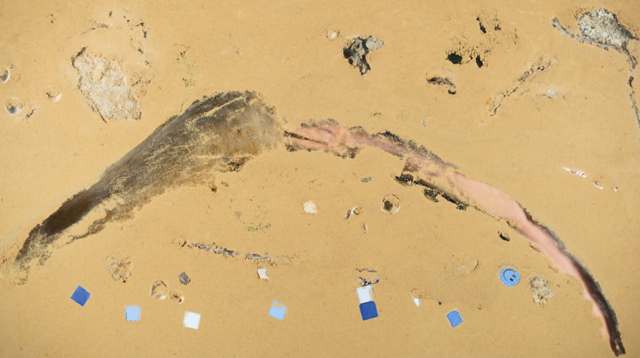
Hands, by Sigalit Landau.
A fragment of a spectacular work by Sagalit Landau, ‘DeadSee’, is available at the time of writing on Youtube:
A double interview, together with Palestinian-Lebanese Zeina Barakeh:
[End of Part 1 of this article. Part 2 will continue looking at objects and animation, in videos shown at LOOP Fair 2014 and include videos which use voice.]

